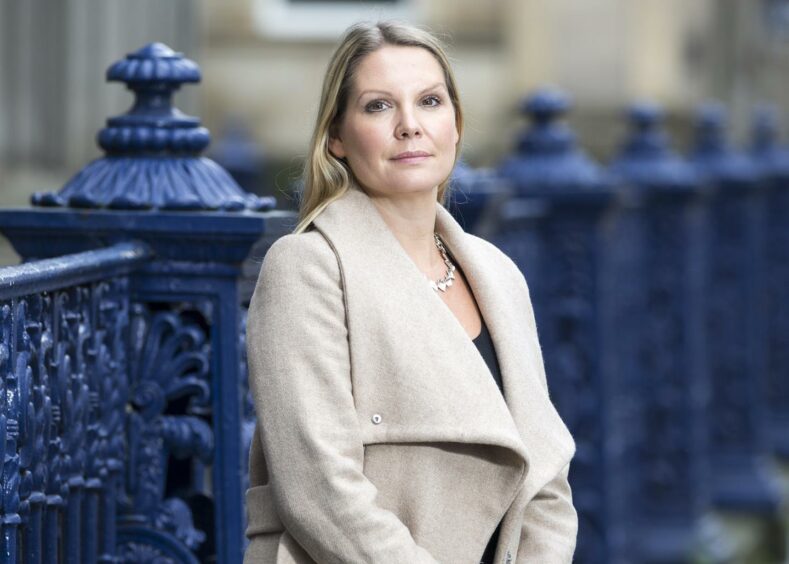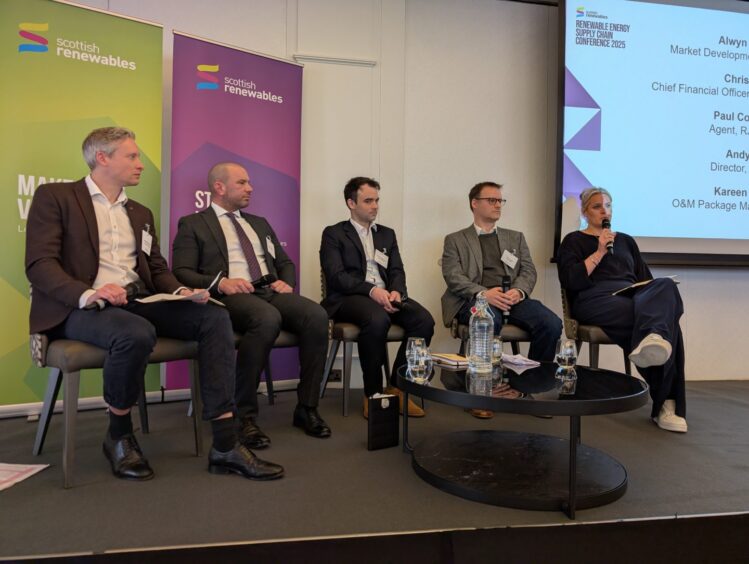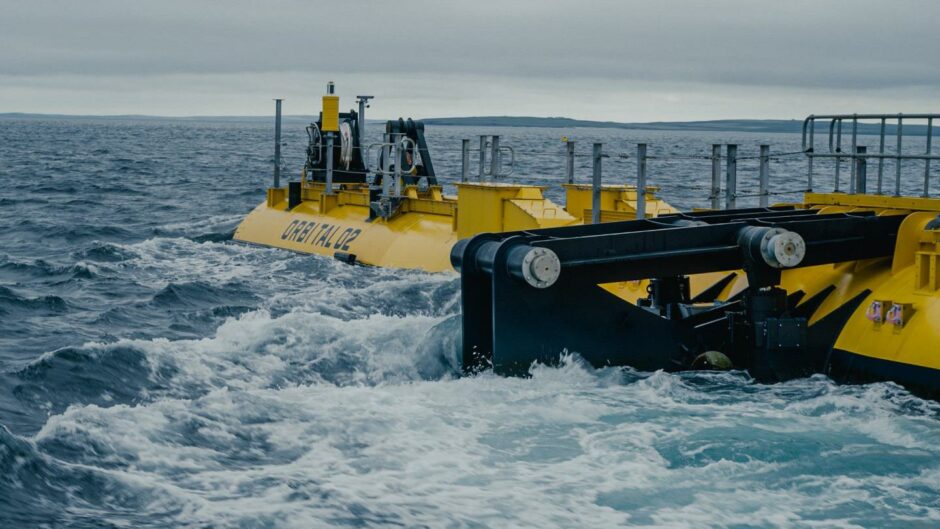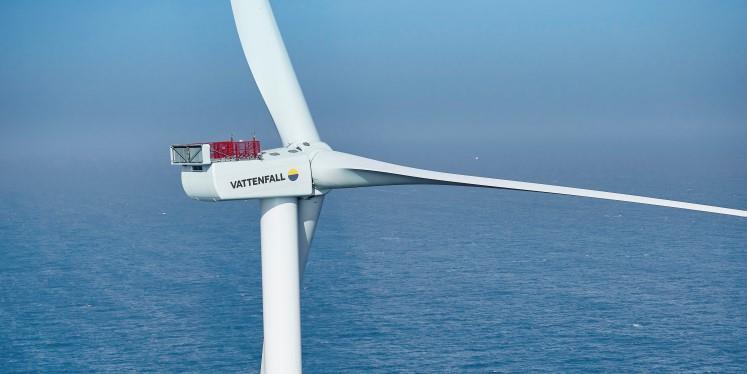The green energy industry “has yet to crack the conundrum of how to drive investment” to the supply chain – but tidal offers opportunities for UK firms, an Aberdeen event has heard.
Developers and suppliers from across the Scottish energy industry gathered at the Granite City’s Chester Hotel on Thursday to discuss the opportunities that the transition to renewables offers.
Orbital Marine Power chief financial officer Chris Milne was quick to highlight the local content that went into delivering his firm’s O2 turbine, located off the Orkney coast, which began operating in 2021.
He claimed that 80% of the work involved in bringing the asset online came from UK businesses, with the remaining 20% coming from overseas drive train and gearbox manufacturers.
However, even these components offer opportunities for businesses – not in manufacturing but in assembly.
“One of the things that we wanted to speak to you about today was the opportunity that the technical sector, as an emerging sector in Scotland and the UK, can offer to you all,” Milne told the Renewable Energy Supply Chain Conference.
‘We are yet to crack the conundrum’
The chief executive of host organisation Scottish Renewables, Claire Mack, kicked off proceedings by highlighting the emphasis the current Labour government has placed on green energy and the opportunities that offers for suppliers across the country.
Mack added: “None of this is easy, we are yet to crack the conundrum of how to drive investment to you in the supply chain at a point in time early enough to ensure that we are ready to go.
“The pipeline of projects, while plentiful, is still not providing certainty or bankable contracts and commitments to allow you to call off and reserve capacity to make firm plans on staffing and training to build capability, or to buy land and kit to expand your own operations.”
Certainty for suppliers is integral to unlocking the opportunities that the energy transition offers domestic businesses, and this is something that Milne’s fellow panellists discussed in the event’s opening session.
Andy Lyle, director of renewables services company Locogen, touched on this.
He explained: “Projects are getting larger. At the moment, we’re working on an 85 MW solar farm in Ayrshire – currently, the largest operating solar project in Scotland is below 20 MW. That’s four times the size, and I’m aware of even larger projects that are coming through the pipeline.
“So, the trend is for projects to get bigger, but developers and their funders are forced to look towards contractors that have got experience at the scale that they’re delivering. That means a further push towards fewer and fewer contractors, which is squeezing the supply chain and will probably lead to further price increases, which is not good for anyone.”
He later explained that “when developers are looking for non-recourse debt” to fund their projects, “their strategy and procurement is guided by what the funders are looking for themselves”.
As a technical advisor for lenders, Locogen’s job is “to look at the risks associated with the project, in terms of performance, its buildability and then within the construction contracts, the interfaces, and what the risks are between those interfaces.”
From there, Lyle’s firm will flag potential risks which will “slow down the funding process”.
“So, what developers are pushed towards is a reduced number of interfaces, to use larger contractors with more experience in delivering projects of that scale.”
This results in “the same names over and over again” winning work as contracts are dished out to “very experienced contractors” and fewer firms working on the project in question.
However, Lyle said that there are “opportunities” for firms to work alongside Tier 1 contractors to secure work, however, this will require “careful procurement from the developer’s perspective.”
The Locogen boss added: “Not everything can be put on the developers. I don’t think it will happen if that’s the case.
“There needs to be a more proactive efforts to encourage the development of relationships between the local supply chain and the developers and the Tier 1 suppliers so that local businesses and the wider supply chain have the opportunity to get involved in these projects to then help us deliver this vast volume that we have to get to by 2030.”
The ‘significant’ opportunity for UK suppliers in tidal
Smaller projects, such as tidal initiatives, are able to create work for suppliers as well. The UK is currently targeting the generation of 1 GW of power from tidal, 700 MW of which is set to come from Scotland.
Milne said: “We’re trying to build a sustainable industry here in the UK, which means real long-term jobs, not just in the engineering but also the manufacture and the operations.”
He admitted that the supply chain “don’t see a lot” of tidal work; however, the opportunity is “significant”.
“To give you an idea of just how big the opportunity is and how much we leant into the UK supply chain up to this point – we designed, built, own and operate the world’s most powerful tidal turbine, the O2,” Milne added.
“It’s an about 72-metre-long turbine, 2 MW connected to the grid and generating predictable green power up in Orkney as we speak. We used an 80% UK supply chain in the delivery of that.”
He explained that Orbital “got the steel from Motherwell”, welded it in Fife and assembled and launched the asset in Dundee.
He went on to list: “Casting iron Scunthorpe, fabrication in Wales, hydraulic cylinders from Sheffield, mechanical assembly in Workington, wiring in Southampton, and of course installation and long term operational opportunities and jobs in Orkney and the island communities.”
He said that the “amazing capabilities” demonstrated across the UK supply chain have been “underutilised and under invested in for decades”.
“The infrastructure that we already have here in the UK, with modest reinvestment, it’s actually fit for purpose for this new emerging industry,” Milne added.
Wind and supplier visibility
However, it’s not just tidal that is offering up opportunities for UK suppliers; Vattenfall discussed how it is encouraging local content in the roll out of its onshore wind farms.
Kareen French, operations and management package manager for the Swedish state-owned firm, discussed a project in Ayrshire in which it was able to encourage a Tier 1 firm to work with local businesses.
French told: “Our Tier 1 contractor ruled out the Port of Ayr straight away due to storage issues, transportation issues and difficulties with actually using the port.
“We, as Vattenfall, our local liaison officer actually looked into the port, had a meeting with the port and gauged that the contractor was using the wrong information, therefore, we were able to put the Teir 1 contractor in contact with the Port of Ayr.”
When the contractor had “updated information” it was “able to use” the port in a move which “brought millions into the local economy,” French claimed.
She explained that “sharing information and working together is really important” to ensure that UK businesses win the work on their doorstep.
Paul Colebourn, agent for RJ McLeod, later added that, from a supplier perspective, “transparency” is needed to ensure businesses can grasp local opportunity.
When asked what makes a good customer, Colebourn answered: “It’s a transparency and it’s the open conversation because a lot of projects that we’re involved in are dynamic and when you’re tendering it or going through the opportunity it can vary drastically as it goes into the construction phase, through to actual handover.
“So, it’s all about transparency, being open with each other and just helping both parties understand what the risks are, where they lie.”
Renewable energies offer up a mountain of work for supply chain firms up and down the UK that have honed their skills in traditional energy work. However, it is important that developers engage with local businesses and that suppliers make themselves visible for upcoming work.
Recommended for you




 © Supplied by ScottishRenewables
© Supplied by ScottishRenewables © Ryan Duff/DCT Media
© Ryan Duff/DCT Media © Supplied by Orbital Marine Power
© Supplied by Orbital Marine Power © Supplied by Vattenfall
© Supplied by Vattenfall






